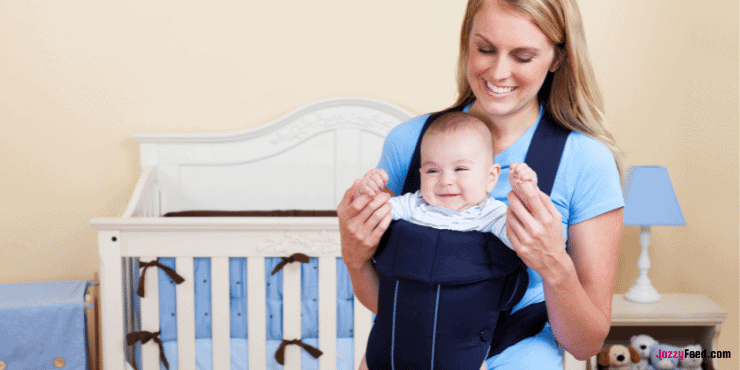Babywearing is becoming increasingly popular, and with good reason. Wearing your baby can reduce crying, make breastfeeding easier, promote bonding, and free up your hands for other things, according to experts. Here’s how to keep your baby safe if you choose to babywear in a carrier.
Do Your Homework
Before you buy a carrier, try out a few different models to see which one works best for you and your child. Attending a local babywearing meeting, where you can see and try many carriers in person, is an easy way to do that, according to Kathy Low, a babywearing educator and vice president of the board of directors for Babywearing International. Once you’ve narrowed down your options, double-check that your baby’s age, height, and weight are within the product’s specifications, look for online safety reviews, and make sure the carrier hasn’t been recalled by the Consumer Product Safety Commission (CPSC). Read the instruction manual and any instructional videos included in the packaging or available on the manufacturer’s website. Before you start wearing your baby, you’ll want to make sure you know everything there is to know.
At First, Practice Using the Carrier Without the Baby
Make an attempt to use the carrier, but don’t put your baby in it just yet. Instead, Low recommends using a doll, stuffed animal, or even a bag of flour to add weight to the carrier. Practice putting on and taking off the carrier. Have someone assist you, but also do some solo runs-throughs. You must be able to put the carrier on and take it off without assistance, buckle it and unbuckle it (with one hand because you will be supporting your baby at the same time), and place and remove your baby without assistance. Once you’ve mastered that, try wearing the carrier around the house (without the baby) to get used to it and see if it’s comfortable throughout the day. Start practicing with your baby in the carrier on the floor, on a soft surface, with a spotter until you have a lot of experience, says Danelle Fisher, M.D., FAAP, chair of pediatrics at Providence Saint John’s Health Center in Santa Monica.
Make Sure the Baby is in the Proper Position
While in the carrier, your baby’s airway should remain clear. Both tucking his chin into his chest and pressing his face up against your body can obstruct your baby’s breathing and lead to suffocation, according to Dr. Fisher. Your baby should be upright at all times, with his face visible, and you should check on him frequently. When it comes to newborns, extra caution is advised. Dr. Fisher explains that carriers require babies to have some neck strength and the ability to hold their heads up. Because there are inserts that support the head and neck, she recommends using a wrap during the first few months (babies usually have good neck strength at around 4 months old). However, make sure your baby meets the age and weight requirements before using one, and check with the manufacturer to see if the insert is compatible with your carrier.
The position of your baby’s legs is also crucial. Legs should not be left hanging straight down because this can obstruct hip development and lead to hip dysplasia (a deformation of the hip joint). According to Dr. Fisher, your baby’s legs should be spread apart and straddling your body, allowing for healthy hip positioning. Additionally, avoid wearing your baby in a carrier for long periods of time. “This is not supposed to be a position where the baby will be for several hours,” Dr. Fisher says. She advises only spending an hour in the car at a time. Then take a break to allow your baby’s hips to move around and avoid becoming overextended.
Dress Appropriately for the Weather
You can wear your baby inside or outside of your coat in the winter. If you prefer to stay inside, Low recommends dressing her in indoor clothes and a hat, putting on the carrier and baby, and then wearing a babywearing pouch, maternity coat, or a coat that’s a size or two larger than your usual coat. Only zip the coat halfway up so you can see your cutie’s face. Dress her in her winter gear and put on your coat and carrier to wear her outside of your coat. Place your baby in the carrier after adjusting the straps to your liking. Never put a blanket over her head. It can affect her breathing, no matter how frail she is.
Low recommends wearing a breathable carrier in hot weather, dressing your baby and yourself in light, airy clothing, staying in the shade as much as possible, and keeping yourself (and your baby) well hydrated.
Take Care
When you’re carrying your baby, your balance may be affected, so keep an eye on your steps. Also, when passing through doorways and turning corners, be cautious. Bend at the knees and support your baby with one or both hands when bending. Low also recommends inspecting the carrier before each use to ensure there are no frayed seams and that the buckles are functioning properly.
In addition, keep these basic safety precautions in mind: When you have a baby in tow, avoid cooking or drinking hot beverages. Avoid driving with your baby in the car, and stay away from activities that put your baby at risk of falling (like running or cycling). These easy steps will make babywearing more pleasurable (and safe) for your child.

